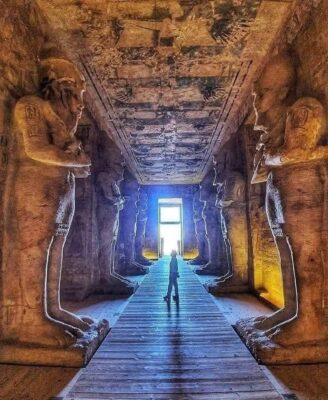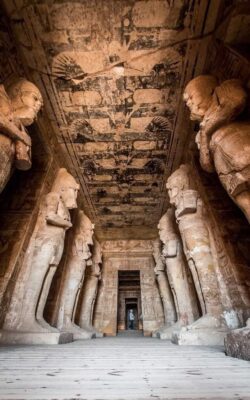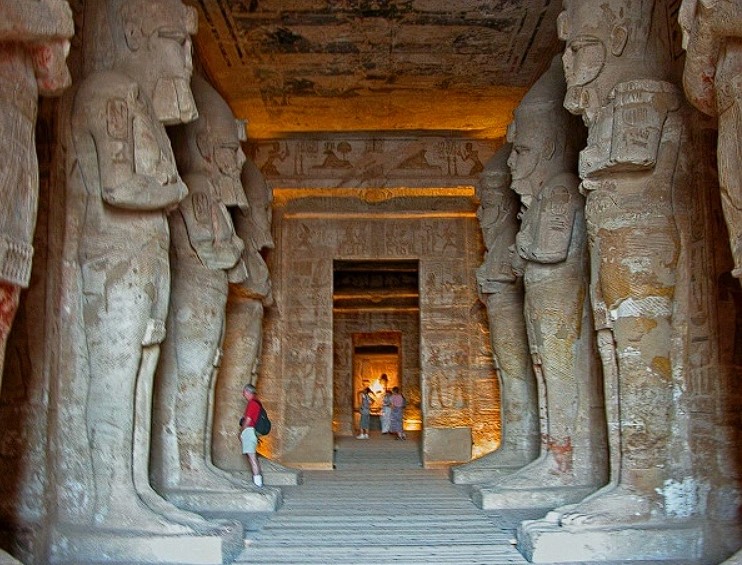The Great Temple Ramesses II at Abu Simbel is one of Egypt’s most iconic landmarks, showcasing the architectural genius and cultural grandeur of ancient Egypt. Located in Aswan, this monumental structure is a testament to the power and influence of Pharaoh Ramesses II. Follow archeology.dulichvn.net to discover many hidden mysteries that have yet to be discovered.

The History Behind the Temple
Commissioned by Pharaoh Ramesses II
The Great Temple at Abu Simbel stands as one of the most enduring legacies of Pharaoh Ramesses II (1279–1213 BC), a ruler renowned for his ambition and grandeur. This monumental structure was conceived not only to glorify Ramesses himself as a divine ruler but also to celebrate his military triumphs, particularly his famed victory at the Battle of Kadesh. It serves as a powerful testament to his reign and an enduring symbol of ancient Egypt’s strength and spirituality.
A Marvel of Ancient Engineering
Carved directly into a towering sandstone cliff along the banks of the Nile, the Great Temple is an unparalleled achievement of ancient engineering. Its construction spanned approximately two decades, involving thousands of skilled laborers and artisans. The temple’s colossal façade, adorned with four 20-meter-high statues of Ramesses II, greets visitors with an overwhelming sense of majesty. Beyond its sheer scale, the temple’s interior features intricately carved reliefs, statues, and hieroglyphs that narrate tales of the pharaoh’s divine lineage and earthly accomplishments. The precision of its construction—executed without modern tools—continues to astonish contemporary architects and engineers.
A Sanctuary of Divine Worship
Dedicated to the gods Amun, Ra-Horakhty, and Ptah, along with Ramesses II in his deified form, the temple exemplifies the integration of political power and religious devotion in ancient Egypt. Its orientation was meticulously planned so that twice a year—during the solar events now known as the Sun Festival—the rising sun’s rays penetrate the temple’s inner sanctum, illuminating the statues of Amun, Ra-Horakhty, and the pharaoh himself, leaving only the statue of Ptah, the god of the underworld, in shadow. This celestial alignment underscores the temple’s spiritual significance and the pharaoh’s association with the divine.
The Great Temple of Abu Simbel remains a striking reminder of Ramesses II’s legacy, embodying the artistry, engineering prowess, and profound religious traditions of ancient Egypt.

Architectural Highlights
The Colossal Statues: Guardians of Majesty
The façade of the Great Temple is dominated by four monumental statues of Pharaoh Ramesses II, each towering over 20 meters in height. Carved directly into the sandstone cliff, these statues are not merely symbols of the pharaoh’s grandeur but also serve as an awe-inspiring testament to the artistic and engineering prowess of ancient Egypt. Their serene yet commanding expressions radiate the divine authority of Ramesses II, underscoring his role as a ruler chosen by the gods. Despite centuries of exposure to the elements, these statues remain remarkably well-preserved, a silent testament to the craftsmanship of the era.
The Inner Sanctum: A Path to the Divine
The temple’s interior is a labyrinth of halls and chambers, culminating in the sacred inner sanctuary. This sanctum houses statues of the gods Amun, Ra-Horakhty, Ptah, and the deified Ramesses II himself. The journey to this sacred space is an experience in itself, as visitors pass through grand pillared halls and intricately adorned walls. These carvings depict a vibrant tableau of the pharaoh’s life: scenes of his military triumphs, elaborate religious ceremonies, and even moments from the daily life of ancient Egyptians. The artistry of these reliefs brings history to life, offering a glimpse into the rich culture and spirituality of the time.
Solar Phenomenon: A Celestial Masterpiece
Perhaps the most extraordinary feature of the Great Temple is its precise solar alignment. Twice a year, on February 22 and October 22, the rising sun casts its light deep into the temple’s interior, illuminating the statues within the inner sanctum. This celestial event floods the figures of Amun, Ra-Horakhty, and Ramesses II with light, leaving only Ptah, the god of the underworld, in perpetual shadow. This phenomenon not only highlights the advanced astronomical knowledge of ancient Egyptian architects but also reinforces the temple’s symbolic connection between the pharaoh, the gods, and the cosmos.
The Great Temple’s design seamlessly weaves art, religion, and science, creating a legacy that continues to captivate and inspire all who behold it.

The Relocation of Abu Simbel
Threat from the Aswan High Dam: A Monument at Risk
In the 1960s, the construction of the Aswan High Dam, a transformative project for Egypt’s economy and agriculture, brought an unintended peril to the Great Temple of Abu Simbel. As the dam was completed, the rising waters of the newly formed Lake Nasser threatened to submerge the temple entirely. This majestic monument, a symbol of ancient Egyptian civilization, faced the grim possibility of being lost beneath the waters, its millennia-old legacy at risk of vanishing forever.
The UNESCO-Led Rescue Mission: Engineering Brilliance
In response to this looming disaster, an unprecedented international campaign was launched under the leadership of UNESCO. This monumental rescue effort, involving experts and funding from over 50 countries, remains one of the most remarkable achievements in the preservation of cultural heritage. The operation, conducted between 1964 and 1968, required the temple to be meticulously dismantled into over 1,000 massive blocks, each weighing up to 30 tons. These blocks were carefully numbered, transported, and reassembled with extraordinary precision on a site 65 meters higher and 200 meters further inland.
The new location was designed to replicate the temple’s original setting, including its alignment with the sun for the biannual solar phenomenon. This ambitious relocation not only saved the temple but also set a global standard for heritage preservation.
Preserving History for Future Generations
The successful rescue of the Great Temple of Abu Simbel stands as a testament to human ingenuity and the collective commitment to safeguarding cultural treasures. Thanks to this meticulous effort, the temple continues to inspire awe and admiration, offering visitors an opportunity to marvel at its grandeur and delve into the history of ancient Egypt.
This achievement not only preserved a physical structure but also ensured that the stories, artistry, and spiritual significance embodied within its sandstone walls remain a source of knowledge and inspiration for generations to come.
See more: Popeye 1980: Robin Williams and Shelley Duvall’s Unforgettable Performances
Conclusion: Temple Ramesses II
The Great Temple Ramesses II at Abu Simbel is not just an architectural wonder but also a symbol of ancient Egypt’s rich history and cultural achievements. From its colossal statues to its celestial alignment, every aspect of the temple tells a story of ingenuity and reverence for the divine. Visiting this site offers a profound glimpse into the legacy of one of history’s most remarkable civilizations.


CÁC TIN KHÁC
Mary Walton: The Forgotten Inventor Who Helped Clean Up America’s Cities
Tomb of Queen Nefertari in the Valley of the Queens, Egypt
Discover the Hypostyle Hall of the Temple of Hathor at Dendera
Venus de Losange: Unveiling the Mystery of a 20,000-Year-Old Paleolithic Icon